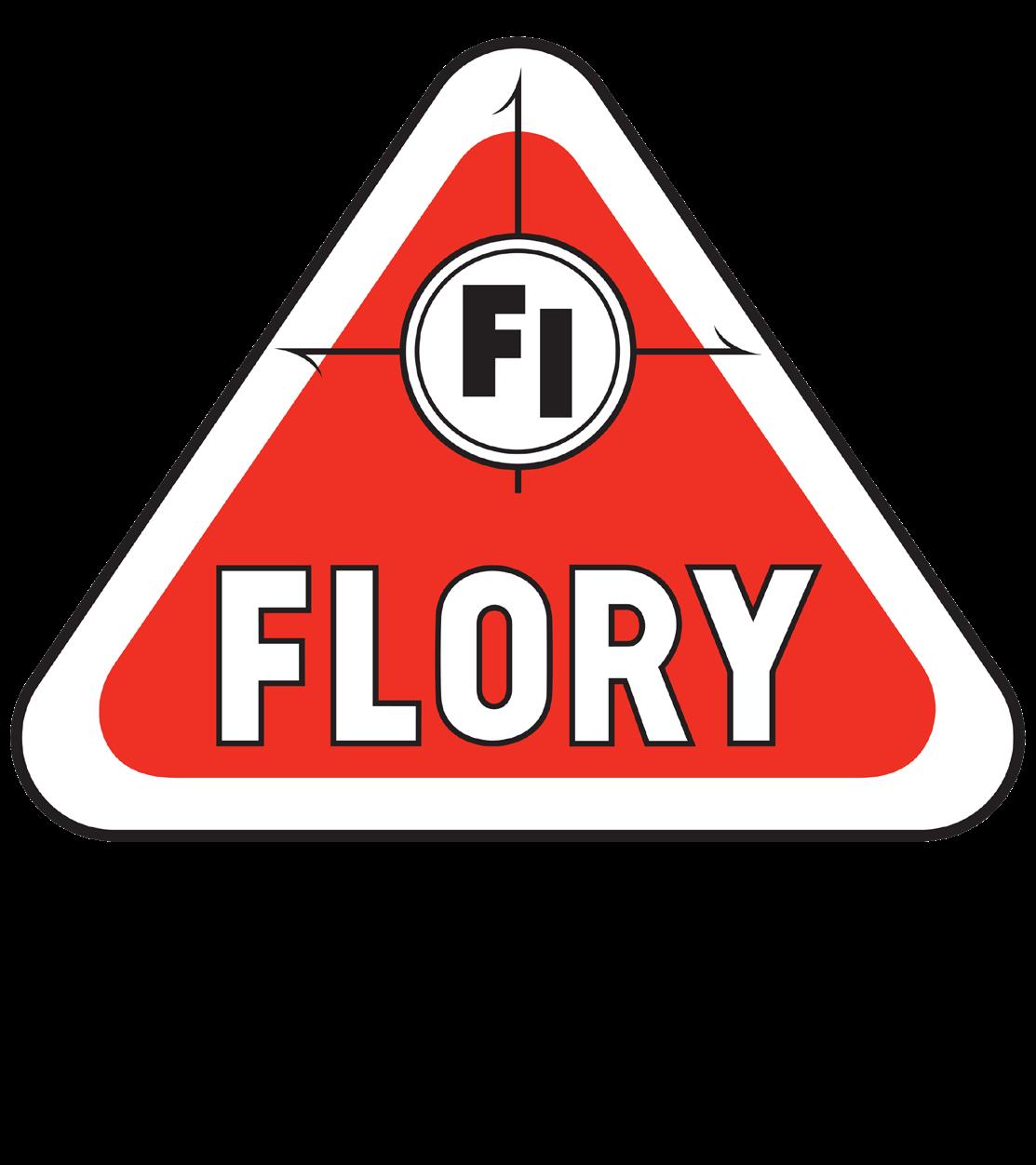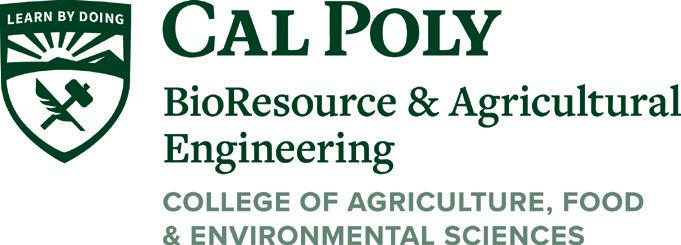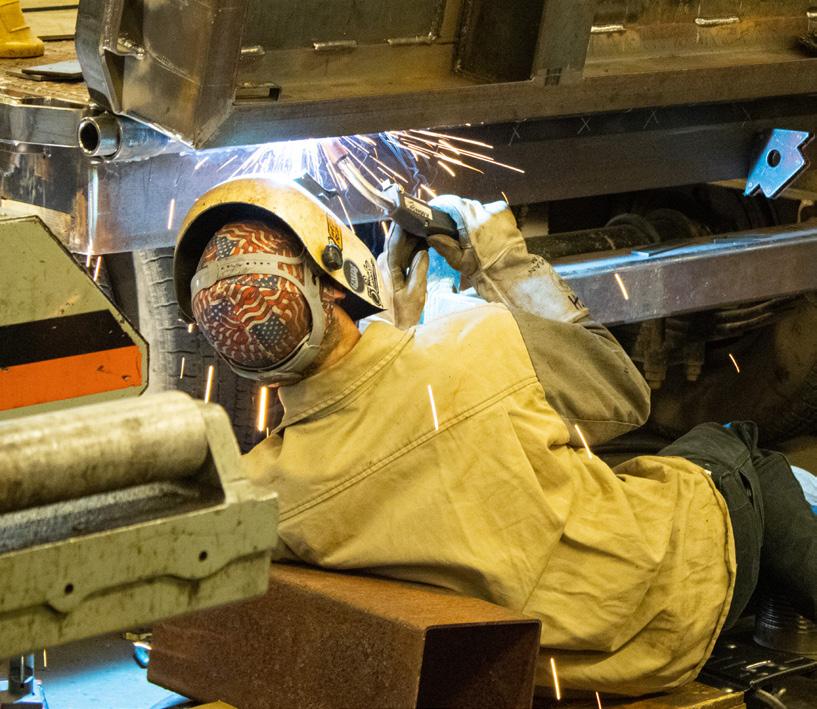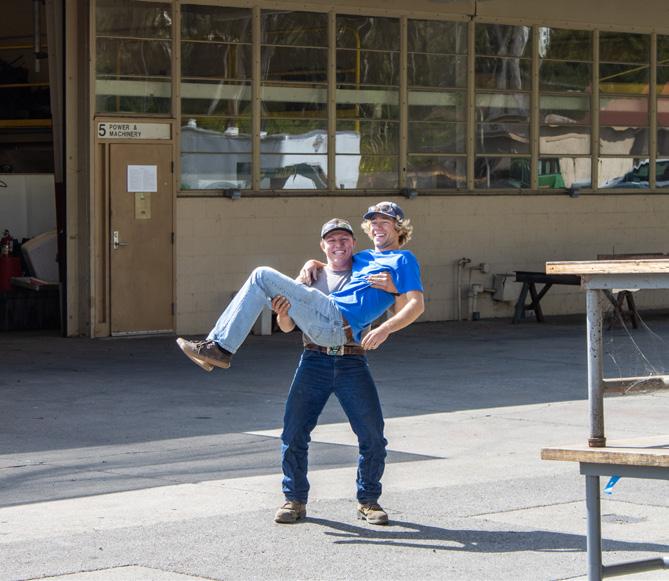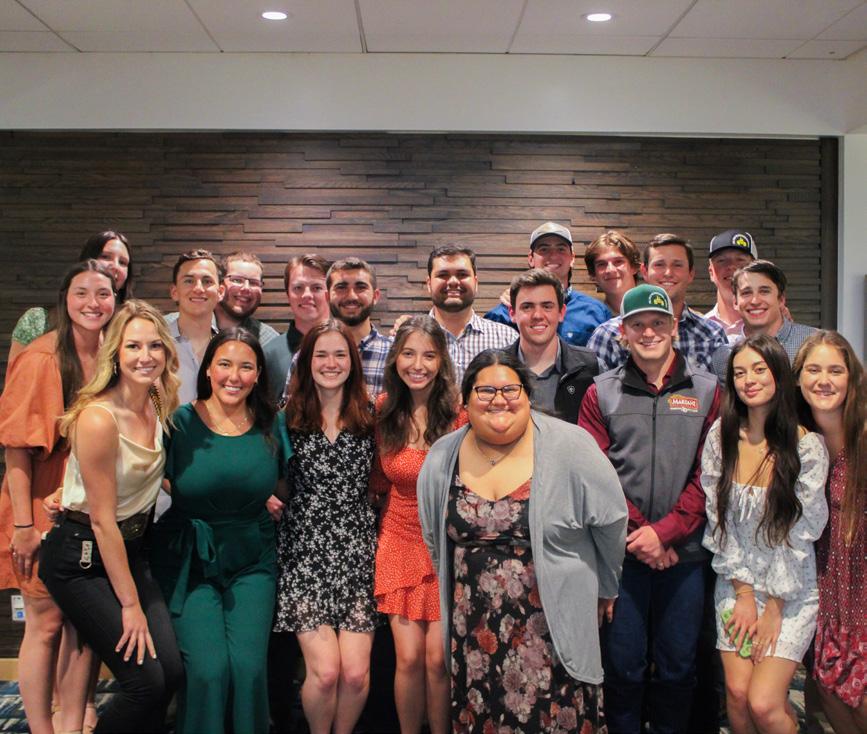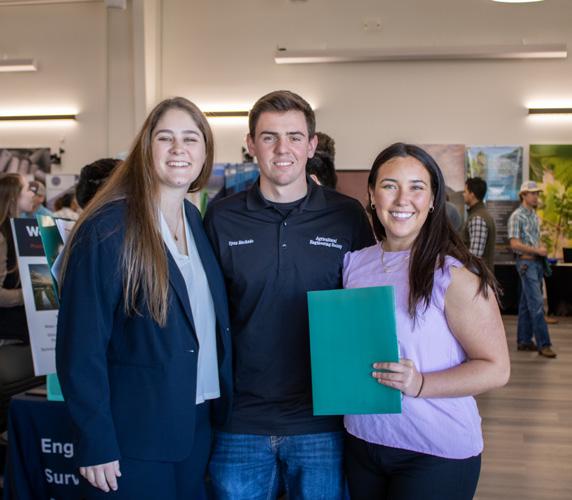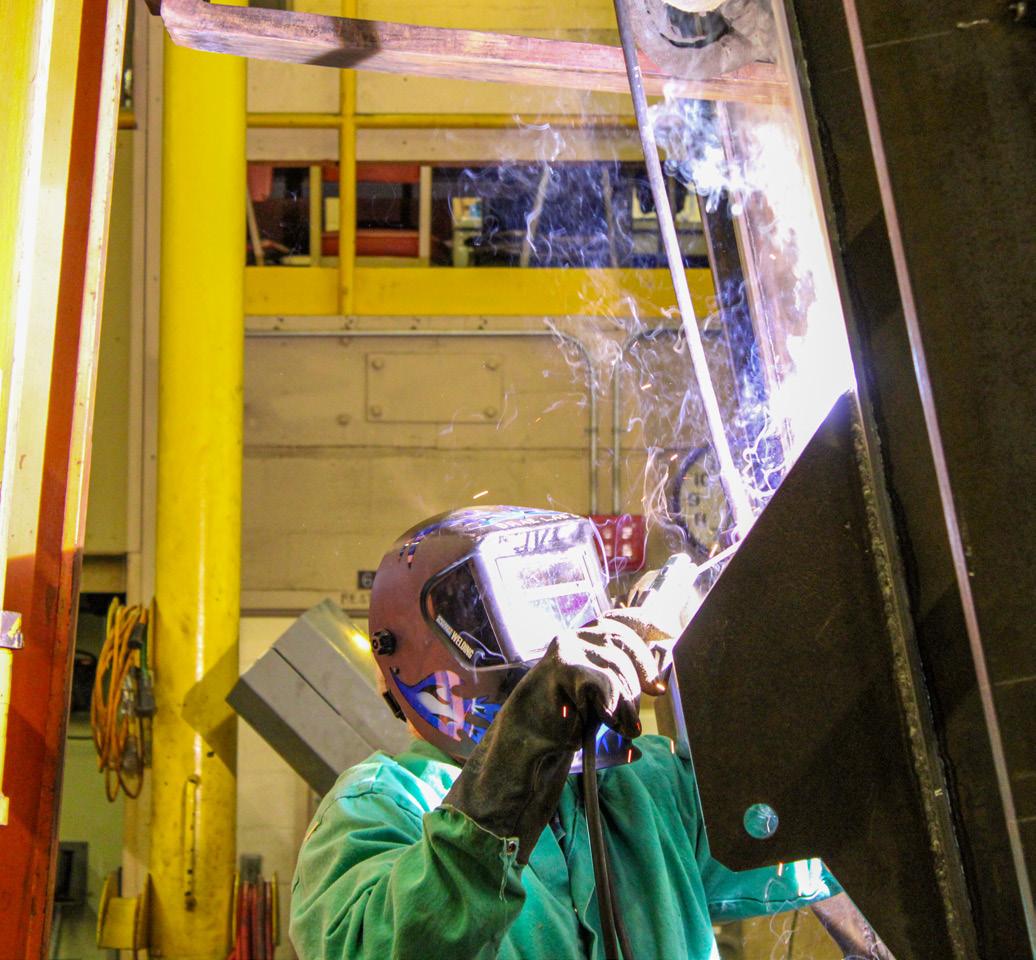BRAE
and Agricultural Engineering Department

Spring 2023
THE LEGACY OF BRAE BBQ
BRAE students keep the grandfathered tradition alive Pages 11-12



Spring 2023
BRAE students keep the grandfathered tradition alive Pages 11-12

Writer: Beyond Borders
Claire Rizzo, third-year agricultural communication
Writer: One Tractor at a Time

Joe Aguiar, first-year agricultural communication
Writer: Strawberry Commission
Andrew Angulo, first-year agricultural communication
Writer: California Yellowtail
Morgan Elia, second-year agricultural communication

Writer: Strawberry Center Bug Box
Lauren Schaap, second-year agricultural communication

Writer: Quarters to Semesters
Victoria Paolini, first-year agricultural communication
Photographer: BRAE Senior Project
Kenneth Bevens, third-year RPTA major | photography minor
Editor-in-Chief
Maddie Tellesen, second-year agricultural communication
I can’t believe another year has flown by, and what an exciting time it has been! This year, our agricultural systems management (ASM) pool of students grew by over 65% as the incoming class of 2023 BioResource and Agricultural Engineering (BRAE) program increased by 25%. Larger numbers of students give us the best teaching efficiency as we fill a 48-student classroom for lectures and continue to have full 24-student lab sections.
I want to give a special thank you to the parents reading this note. You did a great job nurturing and raising your children to be lifelong learners and caring individuals.
The department relies on your contributions of time, talent and treasure. State funds coming into Cal Poly do not cover all costs to provide a hands-on education for our students. The department uses your donations to fund bus trips, buy specialized supplies and support student projects.
This year we added another way to give that directly benefits our students, our Earn by Doing program. Earn by Doing allows the department to hire students throughout the school year to assist in shops and research projects. I extend a huge thank you to Jim Zion and Meridian Growers for kicking off this program, and I also want to thank Paul Burkner for arranging an endowment to honor his brother, Charles Burkner. This will keep the program going for years to come. I hope other friends of the department will consider sponsoring a student in the Earn by Doing program.
Assistant Editor
Kaylen Jaime, first-year agricultural communication
The big news this year is Cal Poly’s 2026 change from quarters to semesters. Our advance planning efforts for this change have been extensive, designing an even better program for our students. I want to thank our faculty, the Industry Advisory Council and advisory students for helping to keep our Learn by Doing philosophy strong.
Peter Livingston paliving@calpoly.eduUPCOMING EVENTS

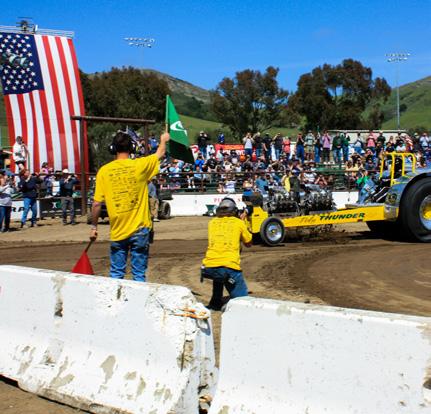




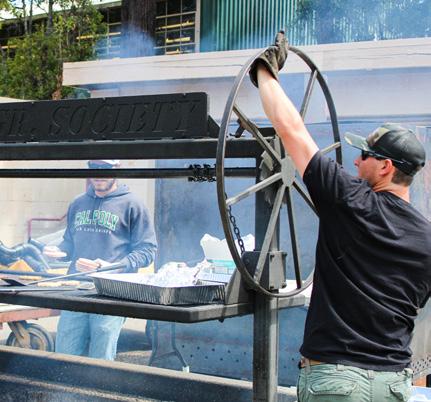
SEPT. 21
Start of Fall Quarter
November
June 15
STAY CONNECTED





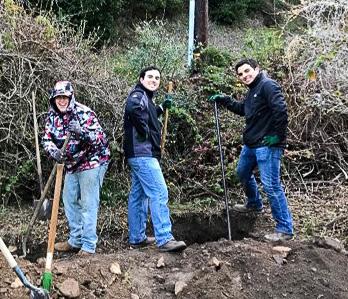
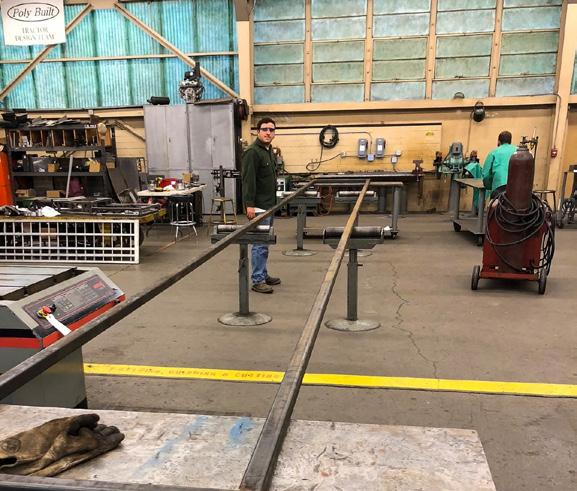
Twin brothers Marcus and Steven Marderosian help manage their family business, Bee Sweet Citrus, with a common love for family, citrus and the Cal Poly Mustangs. When the twins’ older brother, Thomas Marderosian, first toured Cal Poly’s BioResource and Agricultural Engineering (BRAE) Department, the two younger brothers did not expect to find a home at Cal Poly a few short years later. Only a year after Thomas graduated, however, BRAE professors would find the Marderosian names on their class rosters again, as the twins followed in their brother’s footsteps. The twins enjoyed weekly BRAE barbecues and the Quarter-Scale and Tractor Pull events. Assistant Professor Guy Bates had the twins in his senior project class and recalls that they “worked hard on building and installing a rolling gate at Swanton Pacific Ranch.” The boys were “not too excited about sleeping in the yurts at Swanton Pacific due to the spiders and threat of mountain lions.” Marcus remembers his love for the culture, environment and family connections that the BRAE Department offered, while Steven shared how the brothers were “never bored” with the numerous different planning, managing and building opportunities. After graduating, the twins moved back home to help with the family company. Currently Marcus is a sales representative leading a small team managing existing and new accounts, checking production teams and maintaining all orders. Steven is the head of the new mandarin facility, working with innovative technology to increase efficiency for the best boxes, maximum fruit output and highest profit. The brothers continue to support the growing BRAE Department family and look back at their personal time in the department with fond memories.









After John Post spent a few years in agricultural finance and large farm management, he moved to the University of California at Lawrence Livermore National Laboratory in 1989 and stayed until his retirement in 2019. He was a member of the project leadership team for the National Ignition Facility – the world’s largest and most energetic laser system. He also participated in the oversight of several other large projects in the Department of Energy, including actinide manufacturing, particle accelerators, advanced magnetic and inertial fusion systems. Post is a certified project management professional and has been a member of the Global Executive Council of the Project Management Institute for 10 years. During his retirement, he has worked and consulted in the commercial sector, the Department of Energy and several of its national labs in support of their mission in national security and complex project management. He and his wife, Leann, realized a goal common to many Cal Poly graduates and made the move back to San Luis Obispo in 2020. “I miss the good times and great people from my time in the Ag Engineering (BRAE) Department and hope everyone is doing well,” he wrote.

Megan Campbell has been working with Jacobs Engineering. Half of her time is spent on conveyance engineering projects, including designing two pipelines: one to convey recycled water from a wastewater treatment plant to new housing developments, and one to convey water from an irrigation canal to an aqueduct. “The BRAE Department prepared me perfectly for these projects,” Campbell said. “The curriculum from BRAE 236, 312 and 414 gave me knowledge and experience to feel confident in my design choices.” The other half of her time is spent on fish passage projects. These projects consist of replacing old bridges or culverts to allow for adequate flow and space for salmonids to cross under highways. According to Campbell, the BRAE Department and professors have shaped her into the professional that she is today. Her involvement with the department’s clubs and events prepared her to lead events and groups within her workplace. “I encourage everyone to get involved in the department and to make the most out of their time at Cal Poly.”
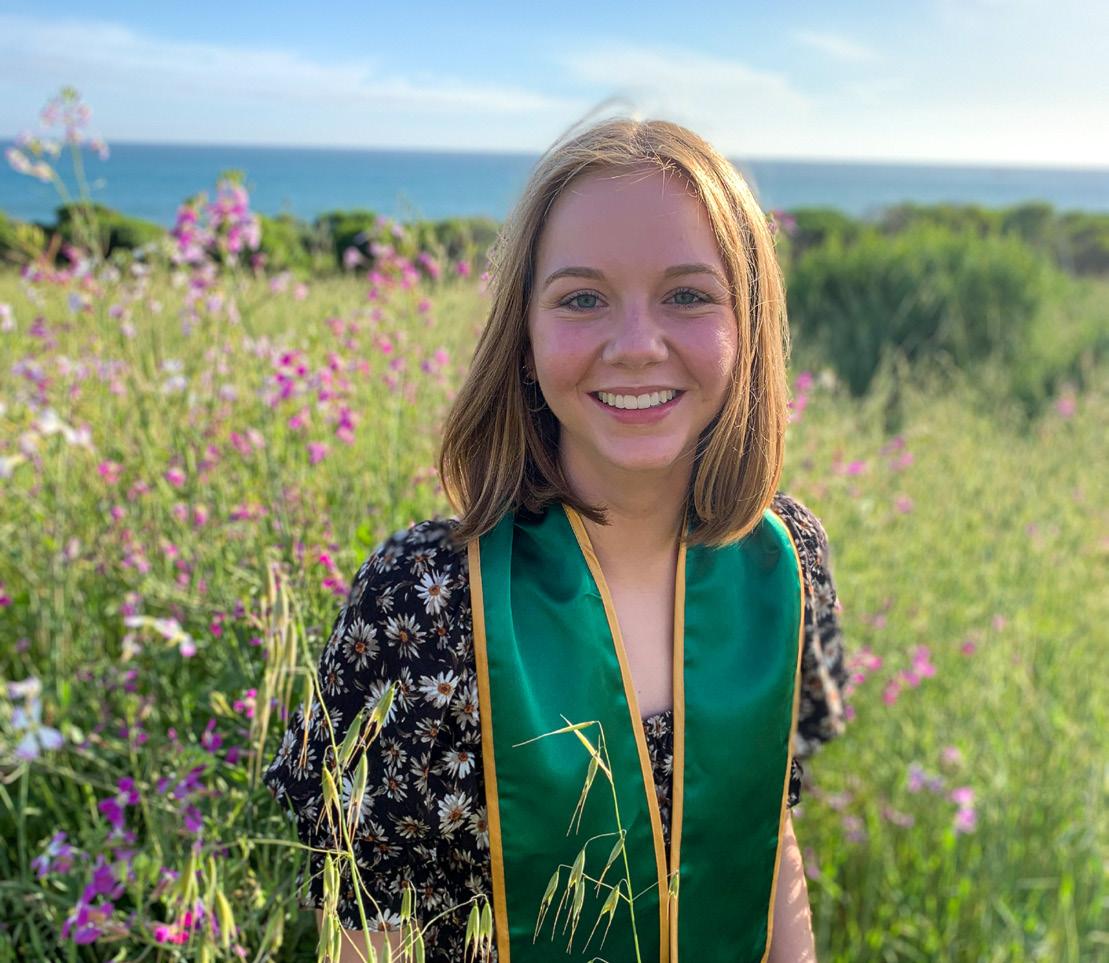
After nearly five years and much planning, a team of Cal Poly students brought safe drinking water to almost 300 residents living on an island in Fiji.

In 2017, Seru Moce, district representative of Mali Island, Fiji, reached out to students in Engineers Without Borders (EWB) to see if they could help improve island water conditions. A plan was devised that would take a team of EWB students across the globe to increase water quantity and quality for communities affected by climate change in Nakawaga, Ligualevu, and Vesi villages.
After consulting with Seru and EWB advisors Peter Livingston, head of the BioResource and Agricultural Engineering (BRAE) Department, and Dawn Neill, professor of anthropology, acquiring safe drinking water became a priority for the Fijian people.

Community surveys suggested that water quantity and quality could be improved with various systems, including solar-powered borehole pump systems and Sawyer household water filters, as well as by remotely assessing rainwater collection systems.
The EWB-Fiji team included team leader Geneva Newell, a fourthyear civil engineering student; Cami Lowrey, a fourth-year bioresource and agricultural engineering major and team filtration lead; Jillian Buteau, a third-year civil engineering student overseeing health and safety; and Andrew J. Klein, a fifth-year electrical engineering major in charge of electrical engineering projects.
From Aug. 2 to Aug. 30, 2022, four students and two advisors implemented 32 rain catchment tanks, increased the island’s water capacity
by 171,600 liters and provided safe drinking water to 280 residents.
Community involvement was one of the key pieces making the program feasible. As Livingston said, “The culture is as important as the projects. None of these projects would become lasting if it wasn’t for the cultural side.”
To enter the villages, the traveling group had to take part in a “Cebu Cebu” ceremony to introduce themselves to the community. Drinking a cultural drink symbolized acceptance, forgiveness and friendship to the chief and his spokesman.
Newell said that the Fijian performance shows that “both sides are agreeing to support one another, which is really cool.”
Livingston added, “The people are
what make Mali Island so special.”

Klein’s favorite memory was also about the people and the community. He enjoyed “sitting around the copper bowl with everyone. We would be there, all the lights would be off, and you could see the stars and just be drinking kava with the residents of these island communities … hearing stories, hearing them joke and make fun of each other while being welcomed. That was really a unique privilege – just being treated like family and friends.”
Waking up to the sound of drums at 6 a.m., the team got ready to start each project’s tasks. With a boat as the main mode of transportation, the team traveled with the tides between the three separate villages. Klein explained how creating the projects “was very much a joint effort” as the
communities wanted to “participate in it so that they could fully take ownership of it.”
Integrating these systems – not just implementing them – within the Fijian people’s lives was the team’s target. Lowrey said that when she was constructing the Sawyer water filters, “The children would follow me to each house. By the third house, they would hand me the next piece that I needed without me having to ask them for it. They just knew how to use the filters.”
Lowrey was excited about the children getting involved. “If the children are learning and taking an interest like it’s a cool new thing, then they can teach their families and really take ownership [and] know how to maintain it,” she said. The team used small sandwich bags

and a testing agent to detect E.coli in water conditions. The water would turn green if contaminants were present. Test results allowed Seru to show the villagers that their water was not clean to drink, convincing them to integrate a microfilter system to clean the water.
In the summer of 2023, the next EWB team plans to install a rain catchment system for teachers’ homes and school system. The new tanks will hold 10,000 liters of fresh, clean water for the children and teachers of Mali Island.
With each new trip, Engineers Without Borders students apply Cal Poly’s trademark Learn by Doing philosophy across the world, helping communities.


TThe Cal Poly PolyBuilt QuarterScale Tractor Team is one of many hands-on learning experiences that exemplify Cal Poly’s Learn by Doing philosophy. Each June, teams from across North America build a quarter-scale tractor to compete in the International Quarter-Scale Tractor Design Competition in Peoria, Illinois, hosted by the American Society of Agricultural and Biological Engineers (ASABE).

The PolyBuilt team is structured into three components: business, design and construction. Team members Jack Fitzgerald and Trevor Topham, both third-year bioresource and agricultural engineering (BRAE) majors, combine their skills to design, plan and compete with the team.
Before teams can compete, the tractors undergo a technical inspection with attention to wiring and kill switch details. Once the tractors are inspected, eligible tractors compete in three contests, including a tractor pull and maneuverability and durability contests. Along with the performance aspects, the team also participates in a business presentation in which the group pitches their tractor to a panel of industry professionals.
Last year, the PolyBuilt team was the only school located west of the Rocky Mountains, and it placed in the top six in each of the three contests. When Fitzgerald was asked about the team’s high level of competitiveness, he said, “We were competing with those big schools. We beat Texas A&M and Kansas State. I think it was
cool to perform at that level with them.”
As the team looks to participate in June 2023, its priority remains focused on tractor performance and a desire to improve the business aspect of the competition. “If we have a tractor that is fairly equal in terms of performance, we need to focus a little more on the business side of things,” said Fitzgerald.
The PolyBuilt team exhibits Learn by Doing at the highest level, using CAD software for design, welding a tubular frame and presenting in front of potential investors. The team continues to compete at the national level among the toughest competitors, one quarter-scale tractor at a time.
Cal Poly, the only campus in the 23-campus California State University system to still offer the quarter system, is officially converting to the semester calendar by the 202627 academic year. Faculty and staff began preparing for the upcoming change in October 2021 at the CSU Chancellor’s request.
Since the announcement, the BioResource and Agricultural Engineering Department (BRAE) and Cal Poly have been working steadily to prepare for a smooth transition.
One of the first steps in the transition process was deciding how to deliver the previous 10-week quarter curriculum into a 15-week semesterbased system. In response, the faculty developed a revised flowchart for both majors within the department indicating which classes will be offered and their prospective units. To avoid the loss of material common in a semester conversion, the BRAE Department is preparing to combine two- and three-course sequences into a single or two-course sequence.




One major concern regarding the
quarter-to-semester conversion is the effect it will have on the fouryear timeline to complete a degree within the BRAE Department. The engineering programs at Cal Poly are all accredited through the Engineering Accreditation Commission of ABET. The accreditation earns validation upon completion of various requirements and courses, requiring 180 to 190 units to graduate. These high standards can make it difficult for engineering students to complete a degree within four years. The good news is that the change to a semester calendar will still allow students to finish in four years.
Despite the changing academic calendar, the BRAE Department will continue to offer four-unit classes composed of three lectures and a lab. Students already progressing to their degree completion at the time of conversion will have access to universitywide plans to help with their questions or concerns. These resources include “bridge and cap” courses to finish remaining course sequences without adding
to their course load. Despite the restructuring, the BRAE Department will continue to offer an array of engineering courses, including water, mechanical, electrical and civil.
Cal Poly’s transition from the quarter to semester calendar will bring benefits for both faculty and students. The complete process of transitioning to the semester calendar may take time to adjust to, but the Cal Poly BRAE Department is prepared.
-G.W. Bates, professor of BioResource and Agricultural Engineering / coordinator of BRAE Department’s quarterto-semester conversion
Our program is going to be able to maintain its character as much as possible.
TThe California Strawberry Commission relies on young minds to bring innovation into the strawberry production landscape of California. To engage young and ambitious individuals seeking opportunities, the California Strawberry Commission has made significant investments in Cal Poly’s Strawberry Center.

As a result, the program has completed over 150 projects since its inception eight years ago, providing industry-related work experience to more than 110 students embodying Cal Poly’s Learn by Doing motto.
“(Students) are given projects to work on and work with realworld issues to solve,” said Will Kraemer, a California Strawberry Commission production and field engineer.
Kraemer graduated from the BioResource and Agricultural Engineering (BRAE) Department in 2020 and recently came back to teach classes when needed. Kraemer focuses on guiding student-led projects to solve real-world issues regarding California strawberry production.
BRAE students have taken on a multitude of projects, including one specific project that has already made an impact in the strawberry production industry.
California producers have for years been struggling with the impact that Lygus bugs has on the quality of their strawberry crops. These bugs feed on the seed material, which hinders the development of the berries and results in irregularly shaped, cat-faced strawberries.
As a part of their integrated pest management strategy to control the Lygus bug, California strawberry growers have incorporated bug vacuums in their fields. In 2020, a new and more efficient single-barrel bug vacuum design was introduced and was found to be highly effective in capturing Lygus bugs.




“The Strawberry Commission worked with the Strawberry Center and the BRAE Department,” Kraemer said. “There was a group of seniors whose project was to do research for the bug vacuums. In regard to automation and research, the bug vacuum is the highest-performing one that has been totally released to the industry.”
Kraemer supported his students by reshaping the way producers eradicate pests from their fields. Students set off to develop the “doublebarrel” bug vacuum and were supported by the California Strawberry Commission and C&N Tractors to fabricate and conduct field testing on their innovative design.

Through testing, the innovation is shown to increase Lygus bug uptake by 3.1 times that of conventionally used vacuums. According to research by the Cal Poly Strawberry Center, this

is a result of the new vacuum’s increased airflow and an updated design.
“It’s not so much redesigning something new but redesigning something existing,” Kraemer said. “It’s heavy on the problem-solving.”
Garrin Schaap, a third-year BRAE major and student employee of the California Strawberry Commission, is currently working alongside Kraemer to further develop the double-barrel Lygus bug vacuum.

Schaap is working on the development of a Lygus bug monitoring system, allowing producers to monitor the count of bugs being collected through the process. In addition, he is working on an accommodation – an operator aid system – that would notify the equipment operator if the vacuum is of adequate height and correct speed for optimal Lygus collection.


“This collaboration gives me an opportunity to really just have free range on a project,” Schaap said. “I’ve been working with full-time engineers to receive insight and guidance on different parts of the project, there is a lot to learn.”
The California Strawberry Commission is not funded through taxpayer money; it is financed through self-taxation or assessments paid by California strawberry growers. The projects developed by the Cal Poly Strawberry Center, in collaboration with the California Strawberry Commission, are open source. This means that the schematics for constructing the machinery were funded by and intended for the use of California strawberry growers. The machinery is also commercially available through C&N Tractor in Watsonville, California.


 Article by Morgan Elia
Article by Morgan Elia
Cal Poly bioresource and agricultural engineering (BRAE) students, faculty and staff have been hard at work on the California Yellowtail Project – an impressive indoor aquaculture system.


This project focuses on growing marine organisms in a recirculating, multitrophic system away from the ocean, incorporating multiple trophic levels from a food chain. The target fish species involved is the California Yellowtail, and the organisms supported by them include seaweed, algae, oysters and clams.
With sustainability in mind, the system is designed to reuse both water and waste. “The idea is to utilize the resources as best as possible,” said project lead Gregory Schwartz, associate professor in the BioResource and Agricultural Engineering Department. “The solids might be utilized by filter feeders like oysters or clams, and the soluble nutrients would be utilized by photosynthetic organisms, like seaweed, that need those nutrients that are pollutants for the fish.”
Another crucial part of this system is the recycling or recirculating of water, which reduces the amount of water that gets thrown away.
This is the second year of a projected four-year endeavor, and the faculty and students are excited with the
results. By the end of the project, the marine organisms will be used for human consumption.
“Then we start working on evaluating and quantifying energy requirements, water requirements and economic requirements,” Schwartz said. Part of the goal of the project is to improve the sustainability of the multitrophic system.
In addition to the thriving system itself, the project has been successful in creating a valuable learning environment for students. In true Learn by Doing fashion, Cal Poly students play a huge role in the project.
“I’ve gained so much experience doing this,” said Julia Ahern, a fourth-year agricultural systems management student who has been working on the project for about a year and a half. Her current job focuses on the seaweed and algae in the system.
“Most students don’t have the chance to experience hands-on work with a multitrophic aquaculture system,” Ahern added. “It’s been awesome.”
“
“
- Gregory Schwartz, BioResource and Agriculture Enineering Department professor and project advisor
The goal is to get students involved in learning about recirculating aquaculture.




Located near the farm shop on the Cal Poly campus lies a shipping container known as the Strawberry Center bug box. For the past two years, the strawberry bug box has been a work in progress, serving as an excellent resource for students and made possible by the BioResource and Agricultural Engineering (BRAE) Department.
The Strawberry Center bug box is being used for five different projects, working as an incubator for growing clean plants to conduct pesticide and toxicological experiments. Students test the best varieties of strawberries and lima beans to optimize growth inside the box, which provides different growing conditions than a field or a greenhouse. The goal of the bug box is to create an isolated environment specifically automated to adjustable experimental setups for various projects.
Former advisor Sarah Zukoff oversaw the plant optimization factors within the bug box, while Assistant Professor Sara Kuwahara supervises the electrical engineering and irrigation necessary for the box’s operations.
Faculty members and Strawberry Center employees decided to use the shipping container for student projects and research in collaboration with the Strawberry Center and the BRAE Department. Now that the box is operational, they hope it can be a place for students to work on projects and collect quality data for the agricultural world.
Bennett Morris, a third-year BRAE student working with Kuwahara, helps manage and maintain the box’s operating activities. Morris has worked to provide the box with basic setups for a good foundation and is currently working on setting up a webcam system.
“I love working with electrical systems, so I love the idea of being able to set up a system that you can fine-tune to control its every aspect,” said Morris.
Graduate student Kiley Jensen also uses the Strawberry Center bug box for his research project, which includes the insecticide resistance status of two key strawberry arthropods: a true bug known as Lygus Hesperus and the two-
spotted spider mite. He uses the bug box to grow lima beans and observe two-spotted spider mite colonies.
Housing different projects in the same bug box makes it crucial that the insects be carefully kept in their enclosed areas and do not migrate to other experiments. One colony of insects, called the “susceptible colony,” has been raised in a lab for over 60 years and has never been exposed to pesticides. Different student projects often use the susceptible colony as a baseline comparison and test them with a wide range of pesticide dosages to observe pesticide resistance.
Current research provides farmers with up-to-date resistance status of insects in their respective regions. If the best possible chemical recommendations can be provided on a regional basis, there exists the potential to reduce the applications of pesticides on strawberries.
Although the Strawberry Center bug box is still in its early stages, the facility has already proven to be a great system and learning opportunity for students and demonstrates the potential in helping solve growers’ daily problems.


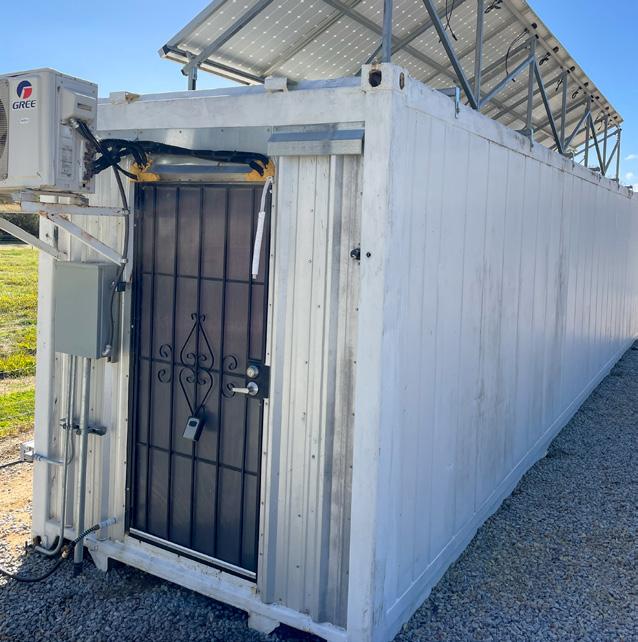
Over fifty years ago, a grandfathered tradition began on the BioResource and Agricultural Engineering (BRAE) ramp. In 1970, the John Deere Company donated a small, gas-powered barbecue to the agricultural engineering and mechanized agriculture students. What seemed like a simple donation for John Deere would shape how the department came together as a community.




At first, the Agricultural Engineering Society (AES) used their new barbecue for club member meals during general meetings. This was the first time club members saw meals provided for at their meetings. After successful meetings and encouraging feedback, the club expanded their reach and started making burgers for students across the college.
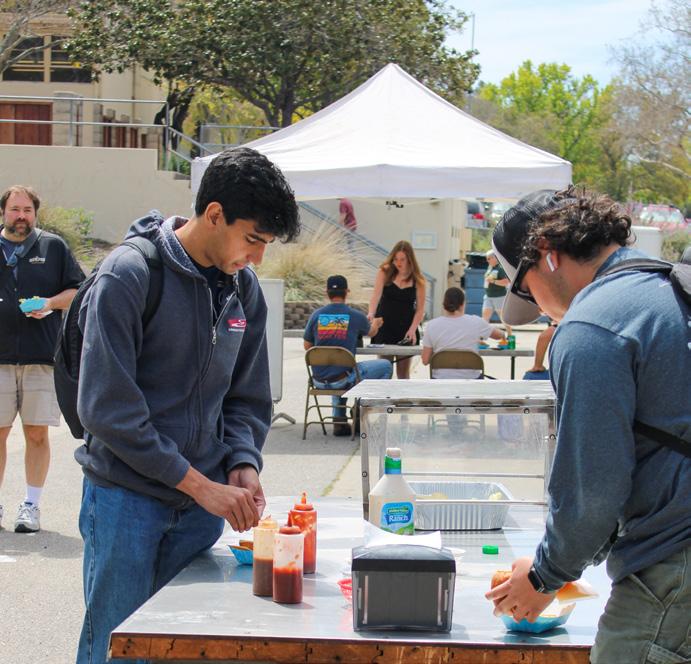
With excited students, a new grill and a few burger patties, the BRAE barbecue tradition was born. One of those students is BRAE’s beloved lecturer, Gary Weisenberger.
“We started barbecuing during college hours in the seventh week of the quarter. After a couple years, we built a big barbecue and started doing it every Thursday,” Weisenberger recalls.


The enthusiasm of a small group of BRAE students turned the BRAE barbecue into a weekly event, beloved by students and faculty across the College of Agriculture, Food and Environmental Sciences. “The barbecue was a gathering of people, the department and friends to get together when there’s no classes and to socialize,” Weisenberger stated.
The iconic BRAE barbecue used today was built in 2005 by a lab class. Weisenberger along with his students designed the grill with steel donated from B & B Steel and Supply.

To this day, the BRAE ramp continues to host the exciting lunch with a meal of cheeseburgers, chili and chips. Over the years, generations of BRAE students have continued to keep the tradition alive every Thursday at 11 a.m.
The volunteer-run lunch allows students to take a break from academics and enjoy time with their peers. As Owen Murphy, a second-year agriculture systems management major and the 2023-2024 Student Mechanized Branch (SMB) president states, “This allows me to make great connections with classmates, professors and industry
experts. It also serves as a way for me to give back to our students.”
BRAE barbecue continues to be at the heart of the unique department. “The thing I love most about the BRAE department is that we are truly one big family,” shares Murphy. “No matter the age gap or class separation, everyone has the same idea that BRAE barbecue is more than just a barbecue. It’s a community.”
The opportunities offered at BRAE barbecue keep students engaged in multiple aspects of the department. First-year agriculture systems management major Sam Esperson explains, “AES was the first opportunity that appeared, so I jumped on it as fast as I could and I have no regrets.” Esperson now serves as the 2023-2024 SMB vice president.
BRAE barbecue is more than a weekly burger. The history and importance of BRAE BBQ continues to shape the growing family at the BioResource and Agricultural Engineering Department as well as the unique community within the College of Agriculture, Food and Environmental Sciences.
- Peter Livingston, BRAE Department Head
The hamburgers are flipped, the benches on the ramp are full. Some are students, others are professionals. Together they blend into the learning that is Cal Poly









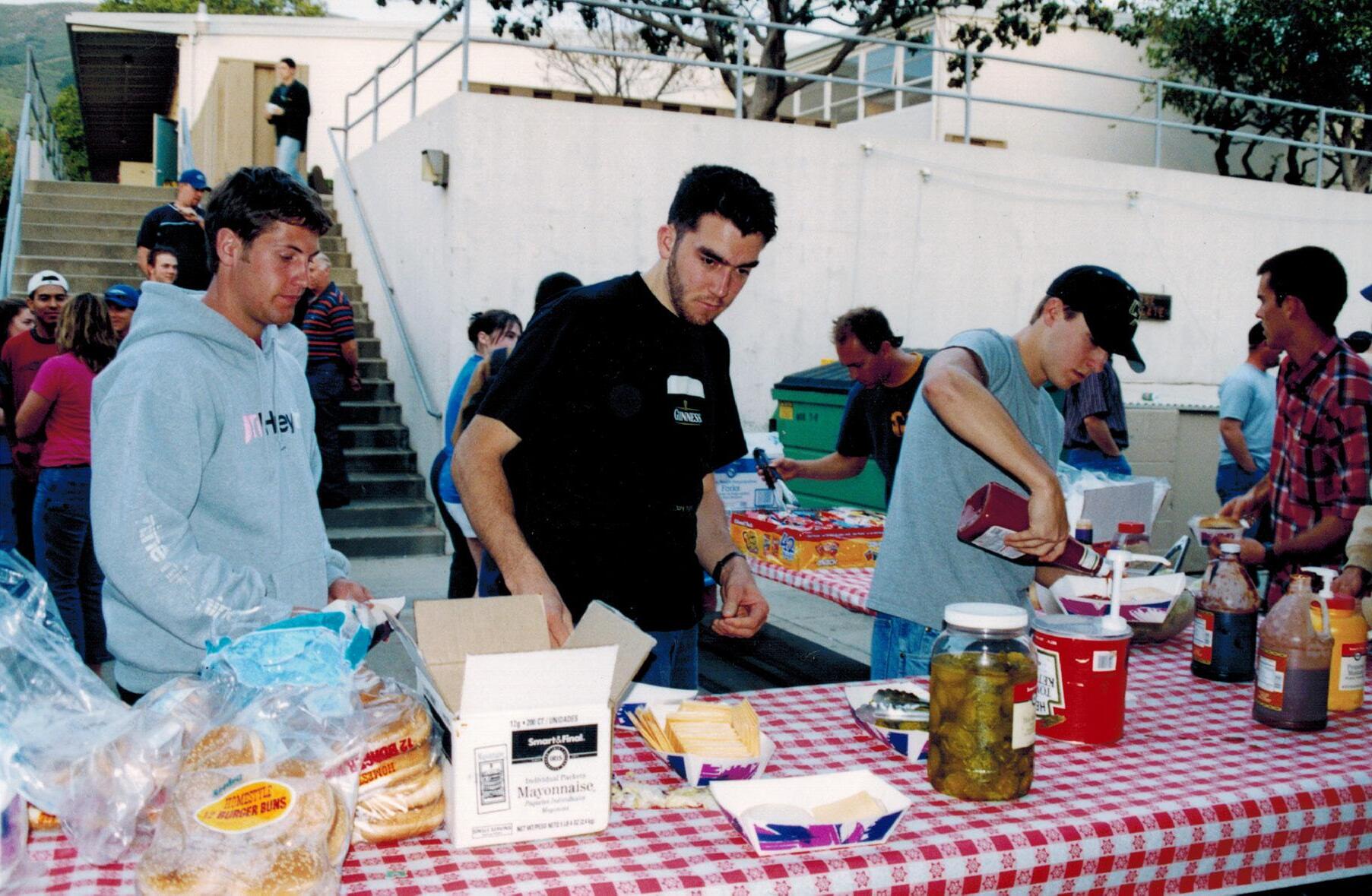





Cal Poly’s Irrigation Training and Research Center (ITRC) has been providing professional services for more than eight years to Native American tribes through an agreement between the research center and the Bureau of Indian Affairs (BIA). The agreement covers lands contained in the federal congressionally authorized Indian Irrigation Projects through the Central Office of the BIA.
The project is led by Professor Daniel Howes in the BioResource and Agricultural Engineering (BRAE) Department. In 2022, the agreement between the ITRC and BIA was modified to include other tasks and an additional $750,000, bringing the funding to over $5.3 million since the contract was first signed by Cal Poly.

The ITRC has completed or is working to complete modernization plans for 15 of the 17 congressionally authorized irrigation projects. In most cases, these irrigation projects were constructed over 100 years ago and for a variety of reasons have not been properly maintained.

The ITRC modernization plans provide a detailed strategy of where and how money should be invested, when it becomes available, to improve district operations, water use efficiency, and meet Tribal water needs, both for irrigation and environmental purposes. Through the Water Infrastructure Improvements for
the Nation Act and other federal and state programs, funding is finally reaching these projects so that modernization construction can begin. The ITRC is supporting the modernization implementation at most of the 15 project sites. This includes design reviews to ensure that the structural designs provided by engineering firms meet the hydraulic design requirements provided by ITRC engineers.
The ITRC-BIA cooperative agreement contract is designed to help improve the operations, safety and effectiveness of BIA irrigation projects. Tasks include:
• Providing irrigation-related training on site at Cal Poly.
• Providing follow-up support to BIA Irrigation Safety Guidelines.
• Supporting the development of a student recruiting and mentoring program targeted toward Native American engineering and water technician programs.
• Conducting modernization studies at BIA irrigation projects.
• Providing general technical support related to technical irrigation issues.
Staff engineers from the BIA’s central office sought out the ITRC to conduct this work because of the center’s 30 years of experience in irrigation project modernization and worldwide reputation. This technical assistance related to irrigation project modernization
has covered over 780,000 acres of agricultural land that generates over $1 billion annually in tribal areas throughout the Western U.S.
BRAE Professor Emeritus Charles Burt, chairman and founder of the ITRC, supervises several BIA projects. He recently completed a modernization plan for the Crow Irrigation Project in Montana that gives the tribe direction on how to best utilize available funds and provides an overall strategy for improving the irrigation project, including important hydraulic designs for sites throughout the system. The ITRC’s plan features details aimed at improving safety, making the system easier to operate and providing better service to the water users. The independent technical assistance was well received by Crow Tribe management. For a graphic of what sorts of services are provided, see www.itrc.org/projects/fiip.htm. This important contract between the ITRC and BIA has helped spread
the Cal Poly brand throughout the Western U.S., expanding awareness of the expertise of graduates from the College of Agriculture, Food and Environmental Sciences and specifically the BRAE program. Just this past year, DOWL Engineering, a firm that works throughout the Northwest on many BIA irrigation projects, hired a BRAE graduate for a water engineering position in a Montana office and has requested a BRAE intern over the summer.


Financial benefits to Cal Poly have included significant funding to cover the costs of research administration through the Cal Poly Research, Economic Development and Graduate Education (R-EDGE) unit, which provides critical support to university centers through services such as managing the campus proposal approval process, approving awards, invoicing and managing personnel issues. The contract also supports the work of ITRC student employees, who are
supervised by registered engineers who work on ITRC staff. The students gain valuable professional experience to add to their resumes. A key benefit to the BRAE Department is additional critical funding to maintain training and teaching facilities at Cal Poly.

Bioresource and agricultural engineering (BRAE) seniors are taking sustainability to the next level with their capstone senior projects. Teamed with Tablas Creek Vineyard, Vineyard Professional Services, and the Upper Salinas-Las Tablas Resource Conservation District (USLT RCD), BRAE students were given the task to create four biochar kilns, two retort and two non-retort.
Biochar is a special kind of carbonrich charcoal that leads to more sustainable methods for farming and utilizing waste. This nutrient-dense compost is a carbon matrix structure designed to hold beneficial bacteria and fungi that increase crop yields and water-holding capacity.
Biochar is unique to other fertilizers due to its capacity to store carbon




and put the nutrient back into the soil, which can result in climate change mitigation practices. The goal for each team is to create biochar generators to assist the Upper Salinas-Las Tablas Resource Conservation District by turning wood chip waste into biochar. These projects also help Vineyard Professional Services mix biochar in with its compost, making it extremely valuable.
Two teams are working on biochar retort reactors – airtight vessels designed to heat up decomposed wood at an extremely elevated temperature, about 600 degrees Fahrenheit, creating an absence of oxygen. This reaction is called pyrolysis, the process of burning wood to retain 50% more carbon once burned, taking the carbon out of the environment. The goal is to produce synthesis gases that continue the heating process, which results in the product biochar. One of these groups completed the task by building a heat chamber below the main chamber. This heating chamber
is the fireplace that moves oxygen into the wood fire, smoldering and exuding synthesis gasses back into the chamber, increasing the heat.
The other two teams are working on a non-retort biochar generator, designed with an open-air top and wood smoldering on the bottom. This process works by creating circulation through placing an abundance of wood in the chamber and lighting the pile on fire. As the smoke and heat sink – due to the baffles placed on top – the heat circulates back down into the wood, creating the biochar after multiple hours.
This year’s senior project embodies the bioresource industry and contributes to more sustainable practices for farming and an alternative method to use waste within the environment. “The team members have done a remarkable job utilizing their skills accumulated over their time in BRAE and have made the department proud,” said BRAE Department Head Peter Livingston.

Agricultural systems management (ASM) students, sponsored by Creston Enterprises, displayed their skills one last time before Commencement by creating three mobile chicken coops.
Creston Enterprises wanted a team of students to “create an ideal situation for the chickens that will be enclosed, allowing for optimization of breeding and protection.” The coop needed to “house 20-25 chickens that would graze lands three days after larger livestock passed through,” helping with pasture fertilization.
Challenged with the conditions of withstanding “all inclement weather” in a safe and “lightweight” structure, three teams in fall 2022 began planning, designing and fabricating their chicken coops at the Cal Poly BRAE ramp.
One of the three chicken coops teams was led by Ben Zanger, fourth-year Agricultural Systems Management (ASM) major, who enjoyed the “creative aspect and general team bonding” of the project. Zanger felt prepared to take on this project’s tasks after the various BRAE classes that offered exposure to everything without being directly involved in the industry.
Zanger said, “Different Excel classes, templates and general problem-solving all gravitate on preparing you” for tasks and projects beyond the classroom.




Zach Tang, project teammate and fourth-year ASM student, also shares the common appreciation for how the professors, classes and community at BRAE changed the students’ learning atmosphere. “In general, the way our classes are structured, we apply exactly what
we go over in lecture right into our senior project,” he said.
The chicken coop senior project required a shaded structure, water tank, trough and mineral supplements, as well as overnight protection. Working on all elements of the structure, Devan Gomes, fourth-year ASM student, was excited to see the visions and materials start to take shape. “Halfway through the fabrication, you see it actually come to life,” Gomes said. “This is actually what we imaged in fall quarter and what was on paper.”
As the project approaches its final stages and the team members conclude their last few classes with BRAE, each of the students look back on their time with fond memories.
- Zach Tang, fourth-year ASM major.
Zanger added, “the people are generally caring and respectful to each other.” He knew that he found a “good community.”
Industry partners continue to come back to the Cal Poly BRAE Department with sponsorships and projects because of their continued trust in its students, facilities and an education that teaches the next generation.

“
I knew our department would allow us to have a project that is actually tangible –something you can look back on




The Grow Crew club focuses on designing, building and maintaining modern growing systems, such as hydroponics, aquaponics, aeroponics and other related systems. The club also operates a climate control room that houses the club’s aeroponics units. The crops that Grow Crew grows include lettuce, chiso and even pumpkins. The club also has relationships with several partners in the modern growing industry.
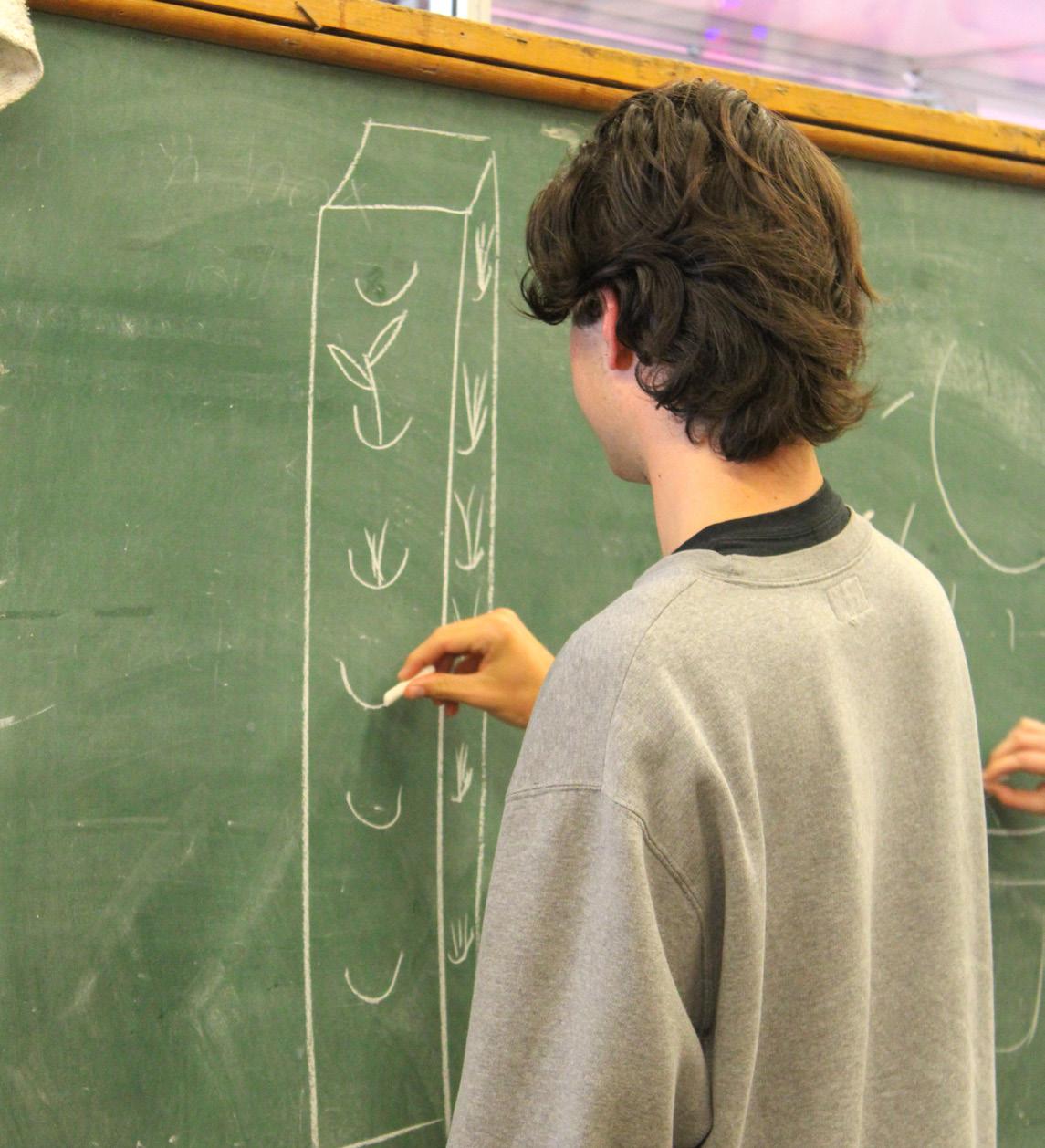
The Precision Agriculture and Automation Club (PAAC) works with micro controllers and sensors to program robots, drones and other applications. The club specifically works on projects in a welcoming environment where everyone is learning and trying to develop skills that they can apply to their future careers. The main project that the PAAC is working on this year is a cotton harvesting robot for the American Society of Agricultural and Biological Engineers (ASABE) robotics competition in summer 2023.

The PolyBuilt Quarter-Scale club is a tractor team that competes at the International Quarter- Scale Tractor Student Design Competition connected to the American Society of Agricultural and Biological Engineers (ASABE) to see who has the best tractor performances.
Students in this club get to design and build a tractor for this competition every year while getting real-world experience.

Future Fuels is an alternative energy-based club that focuses on alternative energy projects like biodiesel reactors, electric bike conversions, solar chargers and more. The club hosts industry speakers to talk about their work in the alternative energy

For many members, “Future Fuels is a great place to meet and work with like-minded students on alternative energy projects. Being able to physically work on projects that are good for the environment can be super rewarding,” said Future Fuels Club President Lance Brown.
Tractor Pull Club oversees building and maintaining the BioResource and Agricultural Engineering Department tractors (Mustang Legacy and Poly Thunder) while competing throughout California. Tractor Pull is also in charge of putting on its own annual Poly Royal Truck and Tractor Pull each year during Cal Poly Open House.

“Tractor Pull means a lot to me because it is the reason I ended up at Cal Poly,” said Tractor Pull Team President Trevor Massetti. “Being able to show others the greatest motorsport in the world, which I was so fortunate to grow up around, is something that I really enjoy doing. I have met some of my closest friends in the Tractor Pull Club!”




The Agricultural Engineering Society (AES) club is the overarching student club that helps bioresource and agricultural engineering (BRAE) and agricultural systems management (ASM) students’ network and gain career development, while providing students the wonderful opportunity to connect with one another.
Some major events that the AES club puts on include the weekly BRAE barbecues, monthly general meetings that include industry panel speakers, annual BRAE Career Fair, and BRAE banquet held at the end of every year. This club allows students to come together through industry and personal experiences.









